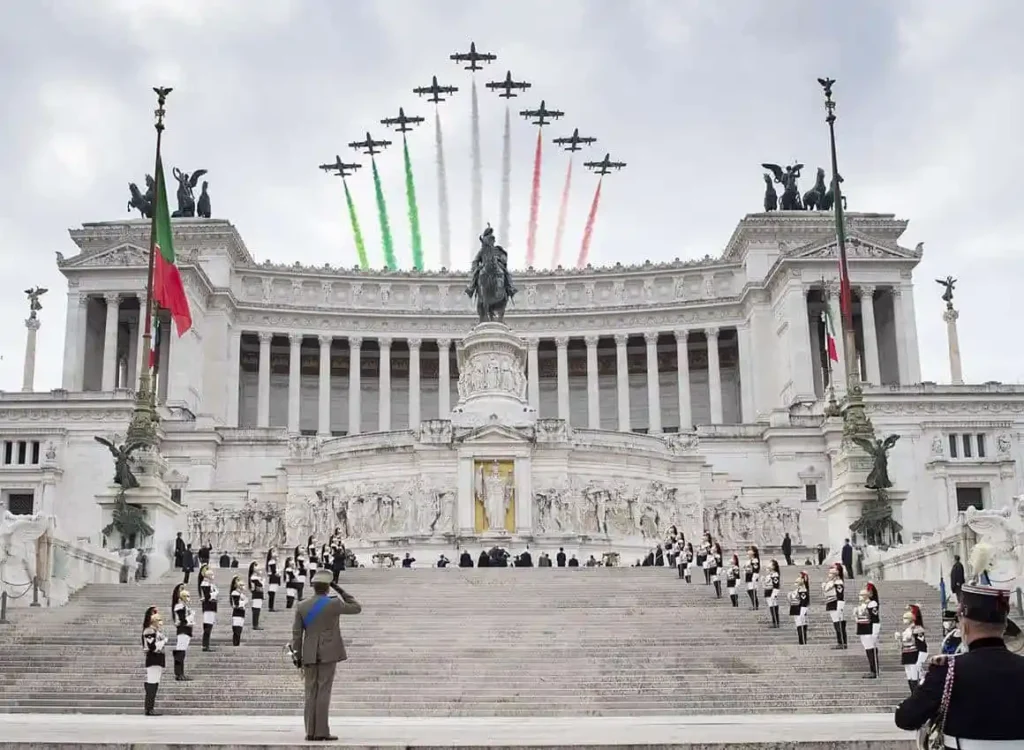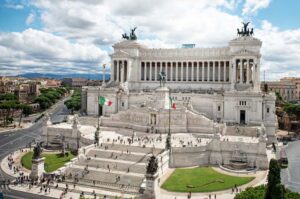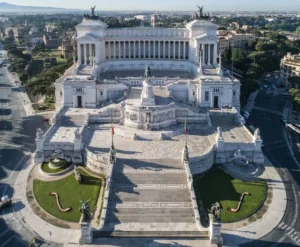Il Monumento nazionale a Vittorio Emanuele II o (mole del) Vittoriano, chiamato anche Altare della Patria, è un monumento nazionale italiano situato a Roma, in piazza Venezia, sul versante settentrionale del colle del Campidoglio; è opera dell’architetto Giuseppe Sacconi. È situato al centro della Roma antica e collegato a quella moderna grazie a strade che si dipartono a raggiera da piazza Venezia. La sua costruzione iniziò nel 1885 e i lavori si conclusero nel 1935; tuttavia, già nel 1911, il monumento fu inaugurato ufficialmente e aperto al pubblico in occasione delle celebrazioni del cinquantenario dell’Unità d’Italia. Da un punto di vista architettonico è stato pensato come un moderno foro, un’agorà su tre livelli collegati da scalinate e sovrastati da un portico caratterizzato da un colonnato.

Ha un grande valore rappresentativo, essendo architettonicamente e artisticamente incentrato sul Risorgimento, il complesso processo di unità nazionale e liberazione dalla dominazione straniera portato a compimento sotto il regno di Vittorio Emanuele II di Savoia, cui il monumento è dedicato: per tale motivo il Vittoriano è considerato uno dei simboli patri italiani. Il Vittoriano racchiude l’Altare della Patria, dapprima un’ara della dea Roma e poi, dal 1921, anche sacello del Milite Ignoto. Poiché questo elemento è percepito come il centro emblematico dell’edificio, l’intero monumento è spesso chiamato Altare della Patria. Fin dalla sua inaugurazione fu teatro di importanti momenti celebrativi. Ciò ha accentuato il suo ruolo di simbolo dell’identità nazionale. Le celebrazioni più importanti che hanno luogo al Vittoriano si svolgono annualmente in occasione dell‘Anniversario della liberazione d’Italia (25 aprile), della Festa della Repubblica Italiana (2 giugno) e della Giornata dell’Unità Nazionale e delle Forze Armate (4 novembre), durante le quali il Presidente della Repubblica Italiana e le massime cariche dello Stato rendono omaggio al sacello del Milite Ignoto deponendovi una corona d’alloro in memoria dei caduti e dei dispersi italiani nelle guerre.

Il monumento ha un’ampia valenza simbolica, rappresentando – grazie al richiamo della figura di Vittorio Emanuele II e alla realizzazione dell’Altare della Patria – un tempio laico dedicato metaforicamente all’Italia libera e unita, e celebrando – in virtù della tumulazione del Milite – il sacrificio per la patria e per gli ideali connessi.
The National Monument to Vittorio Emanuele II or Vittoriano, called Altare della Patria, is an Italian national monument located in Rome, in Piazza Venezia, on the northern slope of the Campidoglio hill; it is the work of the architect Giuseppe Sacconi. It is located in the center of ancient Rome and connected to modern Rome by roads that radiate from Piazza Venezia. Its construction began in 1885 and the works were completed in 1935; however, already in 1911, the monument was officially inaugurated and opened to the public on the occasion of the celebrations of the fiftieth anniversary of the Unification of Italy. From an architectural point of view, it was conceived as a modern forum, an agora on three levels connected by stairways and surmounted by a portico characterized by a colonnade. It has a great representative value, being architecturally and artistically focused on the Risorgimento, the complex process of national unity and liberation from foreign domination brought to completion under the reign of Vittorio Emanuele II of Savoy, to whom the monument is dedicated: for this reason the Vittoriano is considered one of the symbols of Italy’s homeland. The Vittoriano contains the Altar of the Fatherland, initially an altar of the goddess Rome and then, since 1921, also the shrine of the Unknown Soldier. Since this element is perceived as the emblematic center of the building, the entire monument is often called the Altar of the Fatherland. Since its inauguration it has been the scene of important celebratory moments. This has accentuated its role as a symbol of national identity. The most important celebrations that take place at the Vittoriano take place annually on the occasion of the Anniversary of the Liberation of Italy (April 25), the Italian Republic Day (June 2) and the Day of National Unity and the Armed Forces (November 4), during which the President of the Italian Republic and the highest offices of the State pay homage to the shrine of the Unknown Soldier by placing a laurel wreath in memory of the fallen and missing Italians in the wars. The monument has a broad symbolic value, representing – thanks to the reference to the figure of Vittorio Emanuele II and the creation of the Altar of the Fatherland – a secular temple metaphorically dedicated to free and united Italy, and celebrating – by virtue of the burial of the Soldier – the sacrifice for the homeland and for the related ideals.
